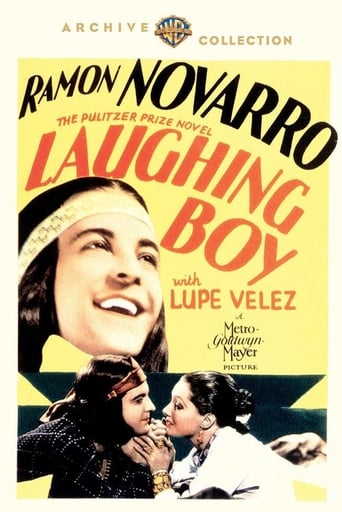JLRVancouver
"Laughing Boy" is a film version of Oliver La Farge's Pulitzer Prize winning novel about a young Navajo man in the early 1900's. Briefly, the story follows Laughing Boy (Ramón Novarro), a traditional youth who travels to a ceremonial dance where he meets Slim Girl (Lupe Vélez), a young women who had attended an "American school" and now lived amongst the white men. After initially disliking her forward ways, Laughing Boy falls in love and, despite objections from his family, the two marry. Slim Girl finds the life as a traditional Navajo women gruelling and starts to return to the 'white' town, ostensibly to sell Laughing Boy's silver-work, where she becomes involved with her former lover. The tragic ending is somewhat abrupt and very different from that in the book. La Farge was an anthropologist who had worked with Navajo and the book, and by extension the movie, are considered accurate and respectful descriptions of Native American life in the Southwest in the early part of the century. The movie lacks much of the detail and 'flavour' of the book, but remains a touching story of love and community in a time when traditional values were slowly being eroded by the temptations of 'modern' lifestyles (like whiskey). The cast includes a number of American Indians in important secondary roles but the leads were both Mexican and don't really look the part, especially when interacting with the indigenous actors (although in the case of Vélez's character, this may be intentional, as she is now 'an outsider'). Music plays a large part in the book but Novarro's singing seems out of place in the film. He has a very good voice but (IMO) the songs would have been better if sung in Navajo (or wordlessly) and without any accompaniment. The black-and-white desert cinematography is moody and beautiful, although many of the back-projection shots (such as the horse racing scenes) are unconvincing and the wrestling scene has been oddly 'sped up'. The movie was a box-office failure and has not aged well (Novarro still looks like a character from a 'silent'), but I found it the story affecting and the scenes of contemporary Navajo life interesting. I would recommend reading the book first.
wes-connors
Singing silversmith Ramon Novarro (as Laughing Boy) attends his first annual "Great Sing Dance." He and other Navajo Natives trade and sell with Caucasian people. At night, Mr. Novarro becomes acquainted with seductive dancer Lupe Velez (as Slim Girl). She's also an American Indian, but was schooled and lived in the White Man's world (as Lily). After initial apprehension, the two become aroused and begin a relationship. Sadly, Ms. Velez is considered tainted by her past association with Whites. She has trouble being accepted as a squaw by Novarro's people, and ventures into town...It's hard to believe this film was based on a Pulitzer Prize-winning novel (by Oliver La Farge). The story does have an intriguing conflict between the "Native" and "White" worlds, but it is not artfully brought to the film. Navarro and Velez have good screen chemistry, but do not impersonate their characters convincingly. Both were often given "ethnic" roles. One of Novarro's advantages in the "talkies" was his singing, and he is in fine voice, here. You will notice the "swastika" prominently displayed on Novarro's Indian blanket - of course, this has nothing to do with the Nazi symbol.**** Laughing Boy (4/13/34) W.S. Van Dyke ~ Ramon Novarro, Lupe Velez, William Davidson, Harlan Knight
David Atfield
The combination of the two dynamic Mexican actors Ramon Novarro and Lupe Velez should have guaranteed a dynamite movie.But someone at MGM, in their wisdom, cast them as Native Americans - a disastrous decision that doomed this film to failure even before it was begun.Both struggle to make their characters even slightly believable, as they try to curb their Mexican passion into some sort of wise aboriginal spirituality. The spitfire in Lupe just can't help but surface, and all Ramon can do is try to maintain some dignity under that terrible wig. His singing is nice but anachronistic, and there is far too much of it.Hard to believe this disaster was directed by Woody Van Dyke, who had made one of Ramon's best silent movies "The Pagan". Novarro was deeply ashamed of this film, and it's no wonder. What is saddest of all about it though is the way it wastes what could have been one of the most exciting star combinations of all time. Just imagine if Novarro and Velez were playing a pair of violently passionate Mexican lovers - what fireworks we would have seen!Shame, MGM, Shame!
Ron Oliver
LAUGHING BOY loves Slim Girl, but she has lived too long among the white man and cannot fit in with her new husband's traditional Navajo family. What will happen when he discovers she has returned to being a prostitute to make them some extra money?Ramon Novarro & Lupe Velez do the best they can with somewhat embarrassing material. Their performances alone elevate the film above the mundane.Director W. S. Van Dyke, known for his vivid on-location films, tries to interject footage shot in the Southwest to lend authenticity to the plot, but the rear projection backgrounds only detract and annoy the viewer.



